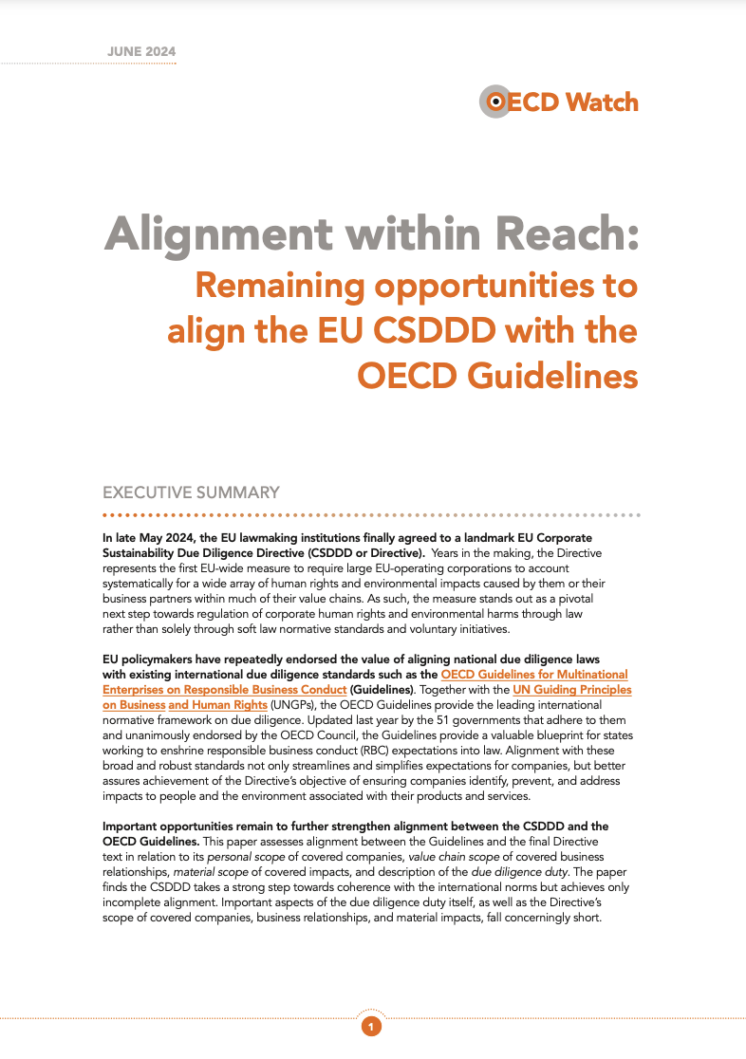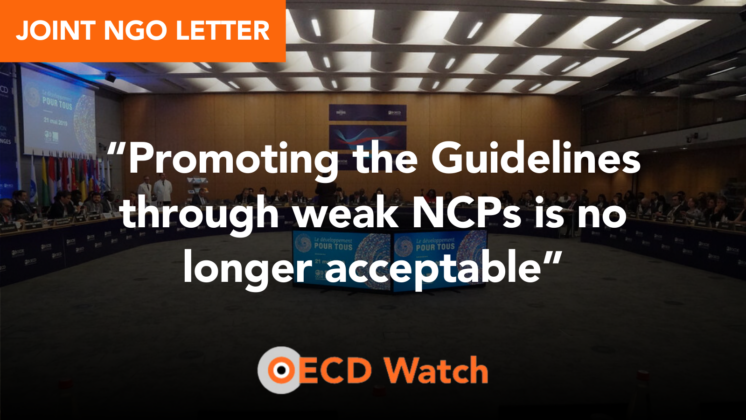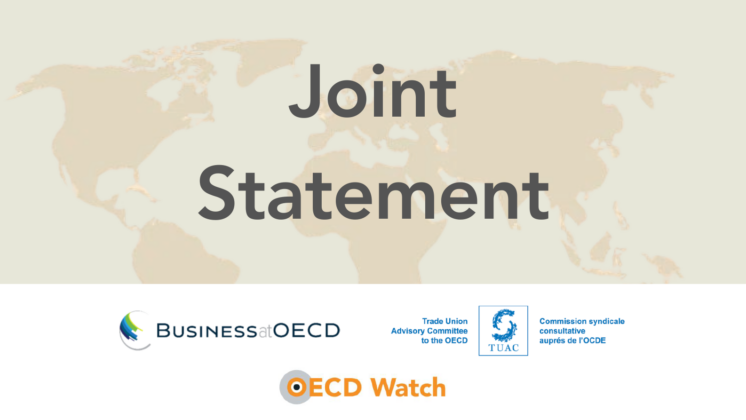‘What a difference a day makes’, or, in this case, a couple of years and a strategic intervention by civil society. Less than a decade ago, the confidence of civil society organisations (‘CSOs’) in the Australian National Contact Point (‘Australian NCP’) was at a “crisis point” following the NCP’s abominable handling of several complaints and ongoing concerns about its structure. Today, after a review and significant reforms of the NCP, the situation is much improved.
This blog post focuses on the Australian NCP and reforms made to its ‘functional equivalence’ under the OECD Guidelines for Multinational Enterprises (‘Guidelines’). While governments are afforded flexibility in the way they organise and structure NCPs, the Guidelines set out four ‘core criteria’, namely visibility, accessibility, transparency and accountability, to promote functional equivalence in their activities. NCPs must at minimum meet these criteria to be effective and appropriate mechanisms in order to facilitate remedy for business-related human rights abuses (UNGPs 27 and 31). Importantly, states must, as part of their duty to protect against human rights abuse, take appropriate steps to ensure that when such abuses occur within their ambit, those affected have access to an effective remedy (UNGP 25). NCPs are a mechanism for states to realise this duty. Accordingly, states should ensure that NCPs comply with the principles and standards for these mechanisms in the UNGPs and Guidelines (e.g. UNGP 31). This is the point of the OECD’s principle of ‘functional equivalence’ among NCPs.
Two NCP complaints are considered in this contribution. The first, filed in 2014, was rejected by the Australian NCP, prompting the first ever substantiated submission against the NCP, an OECD review of its compliance with the Guidelines and, subsequently, significant reforms to the NCP’s structure and procedures. In the second, ongoing complaint, filed in 2020, the Australian NCP has facilitated an agreement between the parties. The stark difference between these two outcomes demonstrates the positive impact of the reforms on the Australian NCP’s remedy outcomes.
2014-2015: Australian NCP rejects complaint against G4S
In September 2014, the Human Rights Law Centre (HRLC) and RAID (Rights and Accountability in Development) jointly filed a complaint against G4S Australia Pty Ltd (‘G4S’) to the Australian NCP. In 2013 and 2014, G4S was contracted by the Australian Government to provide operational and maintenance services at the Manus Island Regional Processing Centre (‘Centre’), an ‘offshore detention centre’ holding asylum seekers in Papua New Guinea (‘PNG’). Among other things, the complainants alleged that G4S had breached its obligations under the Guidelines through its complicity in the Government’s unlawful detention of asylum seekers (contrary to international law). Nine months after the original filing date, the Australian NCP published its initial assessment rejecting the complaint. The NCP reasoned that certain aspects of the complaint “could be interpreted as commentary on government policy” (namely, the Government’s controversial practice of offshore processing of asylum seekers) and that G4S was not accountable for these policies. The complainants appealed the decision, but that appeal was denied in early 2016.
2017-2018: Civil society criticism leads to a review, substantiated submission and subsequent reform of the Australian NCP
In June 2017, the Australian Treasury commissioned an independent review of the Australian NCP. The review was triggered in part by increasingly loud criticism by CSOs of the Australian NCP’s monopartite structure which was composed of only officials from the Treasury and its handling of the G4S case. The final report concluded that the Australian NCP was falling short of its commitments in the Guidelines and was ranked among the poorest performing NCPs internationally. Its structure was described as “inherently problematic” and a “serious concern” on a number of levels, including the NCP’s policies and procedures and complaint outcomes (or lack thereof). Stakeholder confidence was described as “currently at a crisis point”.
In November 2017, OECD Watch submitted the first ever substantiated submission regarding the functional equivalence of the Australian NCP, specifically its handling of the G4S case. OECD Watch claimed that the Australian NCP had not conducted itself in an accessible, equitable and impartial manner and this failure (and similar failures in other complaints) had led to a “loss of confidence” among CSOs and individuals impacted by the activities of Australian companies. OECD Watch described the Australian NCP’s conflation of the state duty to protect human rights with the corporate responsibility to respect human rights as “particularly concerning”.
The Investment Committee published its response to the substantiated submission one year later. The Committee made several findings and recommendations in line with OECD Watch’s submission, including that “In certain respects, the [Australian NCP] did not act transparently or predictably with respect to indicative timelines and in not following its review process procedures” and that certain actions of the NCP had “contributed towards a perception of a lack of impartiality and accessibility.” In relation to the conflation of state duties and corporate responsibilities, the Investment Committee emphasised, “The recommendations of the Guidelines, as well as enterprises’ responsibility to respect human rights, represent expectations of enterprises which are distinct and separate from government duties.”
In response to the independent review report, the Australian Government announced several initiatives aiming to enhance the functional equivalence of its NCP. An independent expert examiner and a new multi-stakeholder governance and advisory board were introduced. The Government published revised procedural guidance and committed to providing resources, as well as improving outreach and promotion of the Australian NCP. According to Australian CSOs, these reforms led to important improvements in the NCP’s functioning. In the Australian Corporate Accountability Network’s (ACAN; a network of Australian CSOs, unions and academics working on business and human rights in Australia) submission to the Australian NCP Peer Review 2021, ACAN highlighted four key improvements: increased efficiency of the complaint process; a more professional mediation service; increased transparency and improved oversight; and a more thorough engagement with the issues raised in complaints and consideration of the Guidelines than was previously the case.
2020-2021: Australian NCP accepts complaint against Rio Tinto and facilitates agreement between the parties
In September 2020, the HRLC filed a complaint on behalf of 156 residents of villages near the Panguna mine in Bougainville, PNG, to the Australian NCP. Rio Tinto was the major owner of the mine between 1972 and 1989 and during this period its subsidiary discharged over a billion tonnes of waste into local rivers. Following the forced closure of the mine in 1989 (leading to a decades long civil war claiming 10,000 to 15,000 lives), Rio’s subsidiary also failed to clean up massive quantities of waste and pollution, leading to ongoing, devastating health and environmental impacts.
On 21 July 2021, Rio Tinto and the HRLC announced that they had agreed to conduct an independent impact assessment to identify, assess and develop recommendations in relation to the actual and potential environmental and human rights impacts of the Panguna mine. The announcement followed 13 conciliation meetings between the parties facilitated by the Australian NCP.
Fulfilling the state’s duty to protect human rights, including to ensure access to effective remedy
In the case of the Australian NCP, the road to functional equivalence has been long and is not at an end. CSOs criticised the Australian NCP’s structure and its negative effect on the NCP’s processes for many years. The NCP’s rejection of the G4S case seems to have been the straw that broke the camel’s back. OECD Watch’s subsequent substantiated submission and the Investment Committee’s critical report increased pressure on the Australian Government to implement significant reforms. Stakeholder confidence in the Australian NCP has risen significantly since the reforms. This is evident from the growing number of complaints filed to the Australian NCP and is bolstered by the substantive remedy outcomes that the NCP has facilitated. A recent report by the Australian Human Rights Institute and the Australian Human Rights Commission described these remedy outcomes as “promising signs regarding its potential usefulness as an avenue to remedy.”
While the 2017-2018 reforms undeniably led to important improvements, Australian CSOs continue to advocate for further reform to the Australian NCP. In ACAN’s submission for the Australian NCP Peer Review 2021, among other things, ACAN called for the NCP’s visibility and accessibility to be increased, for more resources to support the NCP to carry out investigations, for the NCP to make determinations of (non-)compliance with the Guidelines and its recommendations in final statements, and for the Government to clarify that adverse (and unremediated) findings by the Australian NCP impact a company’s eligibility for procurement and trade support. The Australian NCP has travelled far down the road towards functional equivalence, but in order to reach its destination the Australian Government must do more to fulfill its duty to protect human rights.
This blog was first published by the NOVA Knowledge Centre for Business, Human Rights and the Environment (NOVA BHRE)
Suggested citation: K. Booth and J. Wilde-Ramsing, ‘Holding governments accountable for their duty to protect human rights: The Australian National Contact Point and the road to functional equivalence’, Nova Centre on Business, Human Rights and the Environment Blog, 12th October 2021.













